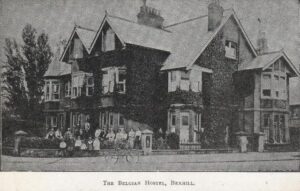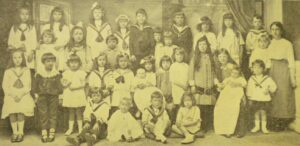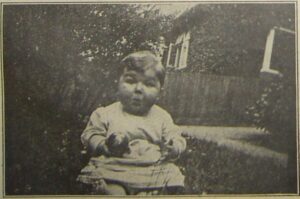Germany’s invasion of Belgium in August 1914 quickly led to a mass exodus of Belgians across the English Channel to Britain. It is estimated that about a quarter of a million refugees had arrived in this country by the end of that year. Although many made their way to London, a significant number of refugees went to Scotland, Wales and the West Country. Seaside resorts were popular because they had many empty hotel and bed-and-breakfast beds. For example, Blackpool housed around 8,000 Belgian refugees during the conflict.
Refugees Arrive in Bexhill
The people of Bexhill reacted quickly to the plight of the Belgian refugees. In September 1914 Templemore, an old and empty convent at 5 Cranfield Road, was donated by the Sisters of Providence to house between 20 and 25 destitute refugees. The Bexhill Belgian Refugee Committee (BBRC) was soon established with 20 members and Mr William Reed-Lewis as Honorary Secretary. The Committee’s headquarters were established in Mr Reed-Lewis’ home at 24 Eversley Road. Mr Reed-Lewis was an American citizen who was already a prominent citizen of Bexhill as he had established in about 1912 the first public library in the town, when about 25 books were made available in the porch of St Mary Magdalene’s Roman Catholic Church. He would become instrumental in drawing the plight of the refugees to the attention of the town as well as actively encouraging the necessary fund raising activities. Hardly a week went by without a letter from him to the local newspapers asking for more help. He was ably assisted in this work by his wife Mary who spoke fluent French.
Bexhill’s first Belgian refugees, four men, unfit for military service, and 10 women and children arrived by train from Folkestone on September 7th 1914. Their first night was spent in the Devonshire Hotel. Fund raising to support the refugees soon gathered pace with events such as concerts, bridge drives and afternoon teas as well as many collecting boxes around the town. In addition clothes, furniture and surplus food were readily donated. Landlords offered empty houses and flats at no or minimal rent. The Corporation reduced the gas, electricity and water bills to houses accommodating refugees. The BBRC tried hard to ensure refugee families could remain together and relatively out of sight to maintain their dignity. There were never any public displays or parades of refugees to create sympathy. The BBRC provided for the needs of each family by knowing each individual’s requirements.
Felixstowe House – Belgian Hostel

Felixstowe House was built in 1902 / 03 on the corner of Wickham Avenue and Woodville Road (where Woodville Court now stands). Initially it was a boarding house and in about 1915 the building became the Belgian Hostel run by Monsieur and Madame Leopold Sas. Although details are still unclear, about 35 Belgian refugees were accommodated there mainly professional and managerial men and their families. There is hardly any reference to this hostel or its occupants in the local papers throughout the whole of the war and there is an impression that these more upper-class refugees kept themselves apart from other refugees within the town.
During the war about 500 Belgian refugees were accommodated in Bexhill but there were only about 200 at any one time. Many were professional or middle class such as lawyers, magistrates, solicitors and two were the wives of Belgian cabinet members. These people brought and spent money in the town but there were many others who were poor and destitute and in need of plenty of support. It is unclear how many refugee children came to the town but photographs in the local papers suggest quite a few. They were sometimes taken for joy rides in large cars owned by wealthy Bexhillians. No accounts have been found regarding these children’s schooling. It has been suggested this was continued in private by teachers amongst the adult refugees and possibly local private schools were also used by those who could afford them.
All the Belgian refugees were Roman Catholics and St Mary Magdalene’s Church played a very important part in giving them both practical and spiritual help during these difficult times. Father Kennedy was especially supportive of their needs. The times of mass were printed in the local papers in languages the refugees could understand.

In general the refugees were well received and supported by the townsfolk. Fund raising was difficult but remained adequate. Language problems were a constant difficulty. A Reading Room was provided at the corner of Sea Road and Jameson Road where foreign language newspapers were available as well as books and games. Free admission was offered at the Colonnade, Kursaal and Bijou Cinema. But there are also first-hand reports of refugees waiting outside Down Elementary School (now King Offa Primary Academy) with their plates thrust through the railings hoping the Canadian troops stationed in the school would give them scraps of food.
Christmas 1914
Christmas 1914 saw about 230 refugees in the town and after an appeal to the public large food hampers were distributed amongst the refugees and toys were given to the children. A lengthy letter to a local newspaper from a Belgian refugee described the beauty of Bexhill especially the sea and the sunsets, the suffering of his country and his fellow countrymen. The writer expressed sincere thanks for the loving sympathy and true friendship of the people of Bexhill. The view of many in the local Belgian community was that it had been the best Christmas we have ever had in our lives.
The London War Relief Fund & Fundraising
Up until July 1915 all funding to support the refugees had come from local sources. But additional funds were now being made available by the London War Relief Fund on a pound for pound matched basis. The first Annual General Meeting of the BBRC held in September 1915 announced that approximately £3000 had been collected and spent supporting the refugees since their arrival.
Two major fund raising activities took place to support the refugees. The War Souvenirs Exhibition was held over five days in August 1914 at 14 St Leonards Road when 200 items of munitions, artefacts and photographs were displayed. Entrance was 6d for adults, 3d for children and £18 was raised. Over August Bank Holiday 1916 an auction was held of over 500 items including signed letters from Dickens, Kipling, Longfellow and Lewis Carroll. The three-day event started at the Colonnade and later moved to the Manor House. A souvenir auction catalogue was also printed but none are known to remain. A total of £157 14s 6d was raised.
The War Charities Act became law in September 1916. This Act was the basis upon which all subsequent charities legislation has been based. Essentially the Act made it unlawful to make a public appeal for money or articles of kind unless the charity was registered and the charity approved the fund raising activity. All suitable charities were invited to apply for registration. However in September 1916 a letter from Mr Reed-Lewis in the local newspapers stated that following discussions within the BBRC they felt they could not comply with the requirements of this new Act. The Committee unanimously felt compliance with the Act would be detrimental to their work and as a consequence they were immediately disbanding the BBRC. They would not accept any further contributions from the public although all remaining funds would still be used for the support of refugees. Thereafter arrangements would be made with colleagues in London to care for the town’s refugees once local funds were exhausted. This sudden decision is difficult to understand. The membership of BBRC was still strong and fund raising was still adequate to meet the needs of local refugees. The BBRC claimed the new law would create more publicity for those receiving the Committee’s support, this it strongly opposed, as well as higher book-keeping costs. Yet by the end of 1916 at least 50 other charities within East Sussex alone had registered under the new Act so it remains difficult to understand the BBRC’s decision. Also at the end of 1916 nobody then knew how long the war would last and what needs may be created by future refugees. Despite this sudden decision there were letters from refugees, town councillors, the London War Refugees Committee to the local newspapers thanking the BBRC for all its work. No critical voices were raised in public. So from September 1916 to the end of the War there was no co-ordinated support of the Belgian refugees in Bexhill.
1916 – 1919
By October 1916 there were 84 refugees in the town and the Belgian Hostel remained in use, especially by refugees with independent means, until early 1919. No births within the refugee community were recorded in the local newspapers but official birth records have not been reviewed. One marriage took place in September 1918 between two Belgians. Five deaths were recorded amongst the refugees, four in 1915 and one in 1919; all five were buried in Bexhill Cemetery. There were no headstones because of the costs involved but the plots used have been identified from Cemetery records.

Mr Reed-Lewis was awarded the OBE in June 1918 for his work with the Belgian refugees. He was also awarded the King Albert of the Belgians medal and in 1922 Pope Pius XI made him a Knight of St Gregory for his work in establishing the Catholic Library in Bexhill. Mrs Reed-Lewis and two other ladies of the BBRC were awarded the Queen Elizabeth of the Belgians medal for their work with the refugees.
Belgian refugees remembered on the Peace War Memorial
The Peace War Memorial, at the corner of Sea Road and Magdalen Road was unveiled in November 1919. On the back of that memorial is an inscription dated 1920 dedicated to the Belgian refugees including the names of the five refugees who died. No details of an unveiling ceremony for the refugees’ memorial has yet been found.

